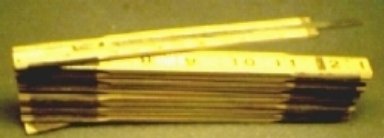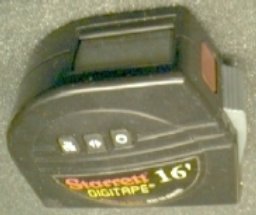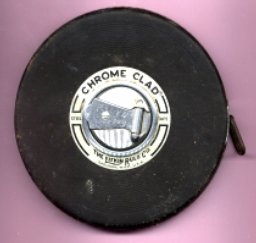There is a myriad of these tools; stiff, flexible, folding, roll-up and shaped; calibrated in almost any dimension and divisions. They may be of paper, wood, plastic or metal. The most durable are steel with recessed, contrasting markings. Painted markings tend to wear off. Selection depends on use. Many can double as straight edges for alignment. Legibility is probably the most important factor. If you can not read it, you can not use it. Divisions should be clearly discernible and identifiable, unless you like to count. Many have tables for conversion of dimensions, or reference to drill bit sizes or other relevant data.
FULL SCALE
FLAT
Very handy 6 or 12" steel rule with clearly marked graduations of 1/32" and 1/64" on one side and 1/10" and 1/100" on the other. Fine divisions on 1/100" scale have long 5; medium 2, 3, 7, 8 and short 1, 4, 6, 9 lengths for easier reading. Craftsman does not sell goodies like this anymore. The MBA's took over.

Note: Adjust brightness and contrast for optimum viewing.
Rule showing 1/10" and 1/100" scales.
For benchwork and drawing track curves, longer yard or meter "sticks" are handy. A pivot can be easily fastened to one end and holes can be located to guide marker. With care, a camera tripod makes a very good center for open benchwork. Longer sizes of 2 yards or 2 meters are very useful for leveling between end points and larger radii. A length of tape running along back side reduces skidding.

Note: Adjust brightness and contrast for optimum viewing.
Folding rules are common among carpenters in preference to long unwieldy rigid rules and twisty, saggy tapes. The ends of each leg are on full inches for inside measurements. Some have a sliding extension bar for odd lengths.

Note: Adjust brightness and contrast for optimum viewing.
Folding rule with extension to the right.
Measuring tapes range from the cloth dressmaker's through the surveyor 's 's reel to sonic and laser types. Locks are necessary on larger spring loaded types. Since a large percentage will be inside measurements, select one that has an integer or easily added value to compensate for case length. Adding 3 3/16" does not have it. Care must be exercised to avoid twisting or bending and tension must be sufficient to avoid sagging over long distances.
A small, thin pocket tape is handy for shopping and quicky measurements.

Note: Adjust brightness and contrast for optimum viewing.
Thin pocket tape
Very useful for laying out curves or positions, this tape has a flip out pivot and a marking hole. A top window with cross hair permits accurate settings in either inches and millimeters.

Note: Adjust brightness and contrast for optimum viewing.
Layout tape with marking hole left and pivot right.
A newer addition is the digital readout tape calibrated in 1/16" or 0.1 cm, with buttons on the side for cm-inch, inside-outside and zero for measuring differences. A set button is on the end, next to the lock. Unfortunately these are not conveniently located, when holding while measuring.

Note: Adjust brightness and contrast for optimum viewing.
Digital readout tape.
For the gigantic layout, large reel and crank tapes are available in hundreds of feet.

Note: Adjust brightness and contrast for optimum viewing.
100' reel tape.
Not quite as accurate, wheel, tapeless measuring devices are available from small drafting or map types through large, long handled, surveyor's types. Handy for measuring curves, they can be used for a good estimate of track lengths. Usually they have a mechanical or LCD digital readout.

Note: Adjust brightness and contrast for optimum viewing.
Medium sized tapeless measure..
Laser "tapes" a far too expensive and from experience sonic types are useless in cluttered cellars . The zero reference on the side is difficult to achieve for inside measurements. while the quoted 5 degree beam width is more like 20; if large object are along the path. Aiming at the target is instinctive not by sight. All of which produce non repeatable measurements. In general, rolling types have inaccuracies due to slippage and path deviation.
SCALING RULES
Often in scratch building, architectural or engineering drawing measurements must be converted to those of the model scale. Among other devices such as proportional dividers, pantographs, calculators, computers and photocopying, scale rules can be used. The tedious process consists of using the relevant rules to measure in the first scale, then to plot or mark on the model in the second. Frequently DIVIDERS are used to transfer lengths.
These are usually classed by the ratio of fractions or integers of an inch to the foot, but occasionally the numerical ratio is seen. Architects commonly use 1/4" = 1' as does O scale. American engineers tend to use decimal fractions like 1/50" = 1". By dividing the smaller into the larger, the numerical ratio can be found. Thus 1/4" scale is often called 1/48 scale. The are some bastard scales such as HO where 3.5mm = 1' or .137795275" = 1' or 1/87.08571429 or 1/87.1 with almost negligible error. OO scale with 4mm =1' is not quite as bad with a ratio of 1/76.2.

Note: Adjust brightness and contrast for optimum viewing.
Architect's wooden & engineer's plastic triangular w/ 6 drafting scales.

Note: Adjust brightness and contrast for optimum viewing.
C-THRU engineer's w/ 7 drafting scales + inches & mm..

Note: Adjust brightness and contrast for optimum viewing.
General 12", O & HO scales w/ fraction, drill bit diameters & tap info.
Available in 6" and 12" lengths, the scales are easier to read than others. It also has 1/64" and .1 mm graduations. Others manufacturers offer other scales.

Note: Adjust brightness and contrast for optimum viewing.
Flint Model Supply 100' N scale.
Includes coupler height, track centers, wheel info and figure hight.
If you ever found a bargain item and wondered if it were to your scale, but had no way to check. The Scale Card is a credit card sized measuring instrument which has a scale rule, man, woman a child figure plus a diameter gauge. There are also 6" and 24" rules. These come in almost every scale.

Note: Adjust brightness and contrast for optimum viewing.
SCALE CARD
Metric scale.
Card.
Since none can handle all jobs, a good selection of the above tools is almost essential for advanced modelling.
BACK TO MEASURING RS HIGHT
BACK TO TOOLS INDEX
